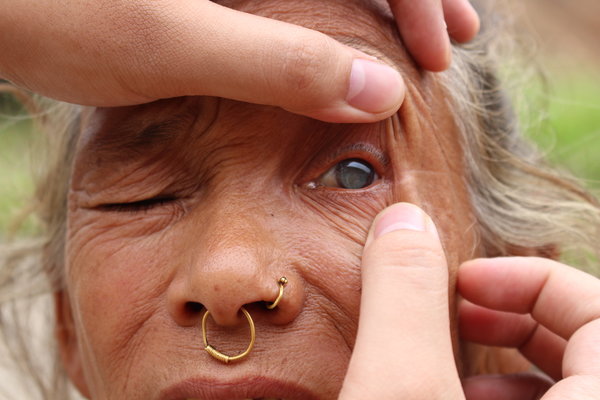In 5 Minutes, He Lets the Blind See
 Nicholas Kristof / Hetauda: WATCHING the doctor perform is like observing miracles. He has restored eyesight to more than 100,000 people, perhaps more than any doctor in history, and still his patients come. They stagger and grope their way to him along mountain trails from remote villages, hoping to go under his scalpel and see loved ones again.
Nicholas Kristof / Hetauda: WATCHING the doctor perform is like observing miracles. He has restored eyesight to more than 100,000 people, perhaps more than any doctor in history, and still his patients come. They stagger and grope their way to him along mountain trails from remote villages, hoping to go under his scalpel and see loved ones again.
A day after he operates to remove cataracts, he pulls off the bandages — and, lo! They can see clearly. At first tentatively, then jubilantly, they gaze about. A few hours later, they walk home, radiating an ineffable bliss.
Dr. Sanduk Ruit, a Nepali ophthalmologist, may be the world champion in the war on blindness. Some 39 million people worldwide are blind — about half because of cataracts — and another 246 million have impaired vision, according to the World Health Organization.
If you’re a blind person in a poor country, then traditionally you have no hope. But Dr. Ruit has pioneered a simple cataract microsurgery technique that costs only $25 per patient and is virtually always successful. Indeed, his “Nepal method” is now taught in United States medical schools.
I’m on my annual win-a-trip journey, in which I take a university student with me on a trip to the developing world to cover underreported issues. The student, Austin Meyer of Stanford University, and I traveled to Hetauda in southern Nepal to watch Dr. Ruit perform his magic on 102 men and women.
One patient was Thuli Maya Thing, a woman of 50 who says she has struggled to look after her children since losing her sight to cataracts in the last few years. Because of her blindness and inability to work, the family sometimes goes hungry. “I can’t fetch firewood or water,” Thuli Maya told me. “I can’t cook food. I fall down many times. I’ve been burned by the fire.”
So Thuli Maya was waiting outside the eye hospital that Dr. Ruit has established here, nervous but also eager with anticipation. “I will be able to see my children and husband again — that’s what I look forward to most,” she said.
She was led to the operating theater, and her eyes were injected with local anesthetic. After hoisting her left eye wide open with an eyelid speculum, Dr. Ruit peered through a microscope as he made a tiny incision in her eyeball and then tugged out the cataract — and placed it in my palm. It was hard and yellowish, perhaps a third of an inch in diameter, a tiny opaque disk that had devastated Thuli Maya’s life.
Dr. Ruit inserted a tiny new lens into the eye and he was done. The process took just five minutes. Then he repeated the process for Thuli Maya’s right eye, confident that she would see again. “Here, the returns are so clear,” Dr. Ruit said as he bandaged her eye. “It’s like no other medical intervention.”
“Here, the returns are so clear,” Dr. Ruit said as he bandaged her eye. “It’s like no other medical intervention.”
(Source: http://www.nytimes.com)
